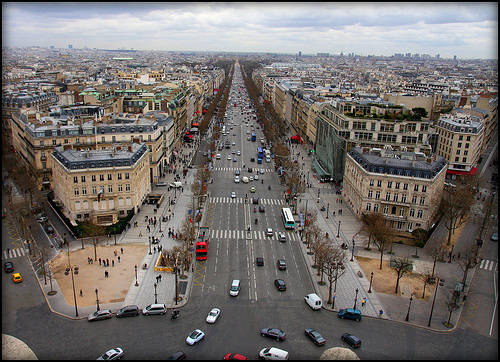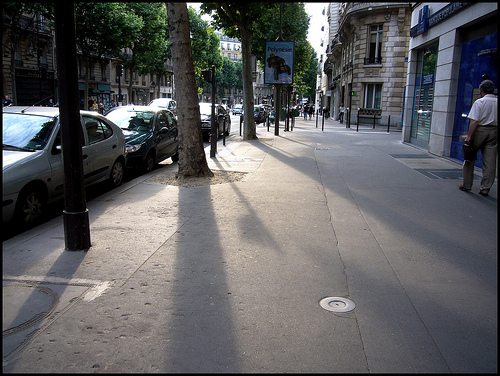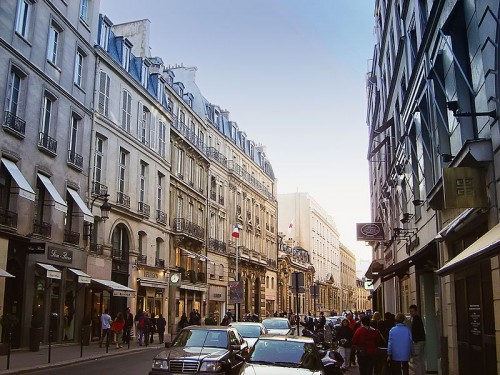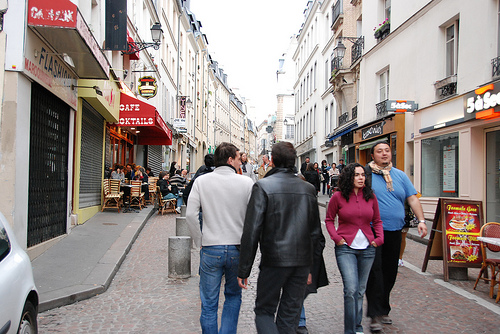The tree-lined boulevards complete with high-end shops, cafés, restaurants, and hotels, have come to define Paris. These distinguished wide boulevards are the work of Baron Haussman, Paris’ urban planner during the 19th century. He rebuilt the streets of Paris between 1853 and 1870, widening the streets to allow for troops and use of artillery.
The older left bank has its roots in medieval history. No matter what street you decide to follow, the walk is always scenic and pleasurable. In fact, one of Parisians’ favorite activities is leisurely strolling down the boulevards, stopping for tea and a macaron, and people watching at a small bistro table outside a café. Put on your walking shoes, leave your worries behind, and head out into the streets of Paris for a relaxing stroll. Here are five boulevards you should definitely explore.
Champs-Élysées
This boulevard may be on your ‘to visit’ list already, but I couldn’t talk about boulevards in Paris without mentioning the Champs-Élysées (pronounced shahnz-ay-lee-zay). The huge sidewalks, numerous shops (including mega-music stores), chic cafés, not to mention the Arc du Triomphe make it Europe’s most spectacular boulevard. Champs-Élysées extends from the Place de la Concorde to the Place de Charles de Gaulle, which is where you will find the Arc du Triomphe, a memorial to the French Grand Army during Napoleon’s reign. Go inside the arch, which has now become a small museum. You can learn more about its history and catch amazing views of the city.
Some of Paris’ most famous cafés are on this boulevard. Stop into Ladurée or Le Fouquet for delicious macarons in pastel colors. The prices are a little steep, but the experience of people watching outside the café with the sun shining makes it worth the price. Along the Champs-Élysées, you will find the Place de la Concorde historical square, which has hosted momentous events such as the Tour de France finale and New Year’s Eve extravaganzas. The shopping transforms into a historical section when you reach the Rond-Point traffic circle. At this square, you can marvel at the Obelisk of Luxor, a gift from the Egyptians in the 1830s. Nearby, you can also visit the Jardins des Champs-Élysées, the Petit Palais, and the Grand Palais, which hosted the World Fair in 1900.
Boulevard Saint-Germain
On the left bank of Paris, you will come across the popular boulevard Saint-Germain. Faubourg Saint-Germain is the suburb that developed around the medieval Saint-Germain-des-Prés church. It was one of the wealthiest suburbs and the cultural center of Paris, but that changed when a new bourgeoisie came about, shifting the center from Boulevard Saint-Germain to Champs-Élysées. The area also served as a workplace for many influential artists and writers including Oscar Wilde, Orson Wells, and Jim Morrison.
Boulevard Saint-Germain is also associated with the intellectuals and thinkers since many of its cafés were meeting places for existentialists. If you want to take yourself back in time to the days of these intellectuals, writers, and artists, order a café au lait at Café de Flore or Les Deux Magots, and soak in the atmosphere around you. This street is a part of the university district (the Institut d’études politiques, one of the best political science schools in Europe, is located in the Saint-Germain neighborhood), which could be responsible for the lively nightlife, artsy and bohemian style, and nonstop energy.
Aside from the cafés, the boulevard is now home to high-end designer boutiques like Armani, Vuitton, Dior, Ralph Lauren Fragonard and Rykiel which makes it an excellent place to window shop.
Rue du Faubourg Saint-Honoré
If you live for fashion, your paradise is on rue du Faubourg Saint-Honoré, the center of haute-couture culture. Almost every major fashion house—Dior, Hermés, Chanel, Givenchy, Yves Saint Lauren, to name a few—is located on this street. Rue du Faubourg Saint-Honoré is narrow and nondescript in comparison to the Champs-Élysées, but is still the top fashion street in the world.
This street isn’t just for fashionistas. The eighteenth century Palais de l’Elysee (residence of the President of the French Republic) is also located on this street. Further down, between Place Saint-Phillipe du Roule and Avenue de Marigny, there are several art galleries housing contemporary art and beautifully crafted and designed French furniture.
Rue des Rosiers
The rue des Rosiers is the main thoroughfare in Paris’ historic Jewish quarter (in the Marais district). As you walk down the streets, you will feel the history of this thirteenth century Jewish community with the Hebrew facades, synagogues, and shtiebels or oratoire (small prayer rooms).
Foodies rejoice! Rue des Rosiers is known for its delicious Middle Eastern and Eastern European specialties, as well as some of the best restaurants in the area. You must visit L’as du Fallafel, which claims (rightfully) to have the world’s best falafel. This sandwich comes with grilled eggplant, cabbage, tahini, hummus, and hot sauce. The shawarma, which is a grilled, skewered meat sandwich, is also a good choice. Wash it down with a big glass of fresh lemonade. After you eat, continue exploring the bookshops, boulangeries, and trendy boutiques. A new vintage shop sprung up on rue des Rosiers recently; Coiffeur offers great deals on unique vintage clothes, shoes, and accessories. So many Parisians love this store that it gets a new stock of merchandise once or twice a week to keep up with the demanding fashion-addicts!
Rue Mouffetard
Rue Mouffetard is one of the oldest streets in Paris (and maybe all of France). It was once a Roman road that went from Lyon to Rome. Now, it is a lively street with a lot to see! At the northern end of the street is the Place de la Contrescarpe, a great people-watching location at night. At the south end of the street is the final resting place of Francois de Paris – the St. Médard church. During the beginning of the eighteenth century, this church was a meeting place for him and his cult of followers. They believed that miracles would be achieved through purification and suffering. After five years, the police shut down the church because of these untraditional beliefs.
Rue Mouffetard’s most popular attraction is the daily market (except for Mondays) that spans across the lower half of the street. Historians have dated this market back to the thirteenth century! Here, you can find fruits and vegetables, cheeses, meats, and other delicacies. The market is busiest on Sundays between 10 am and noon, so make sure you get there early for the best deals. In the evening, this market shuts down and the restaurants open their doors for hungry guests. Most of these restaurants serve different types of ethnic food as well as the traditional French cuisine.
Three times a week, the Place Monge Market is held. This market offers more than just food. You can browse through clothes, shoes, and accessories too. If you want to venture out of La Mouff, Rue Mouffetard is just minutes from the famous Pantheon and Jardin Luxembourg.
What is your favorite street in Paris? What’s your favorite thing to do when strolling down the Parisian boulevards?
Written by : Laura Photo Credits : Joe Marinaro / JR_Paris / David Monniaux / innacoz / andrijbulba





